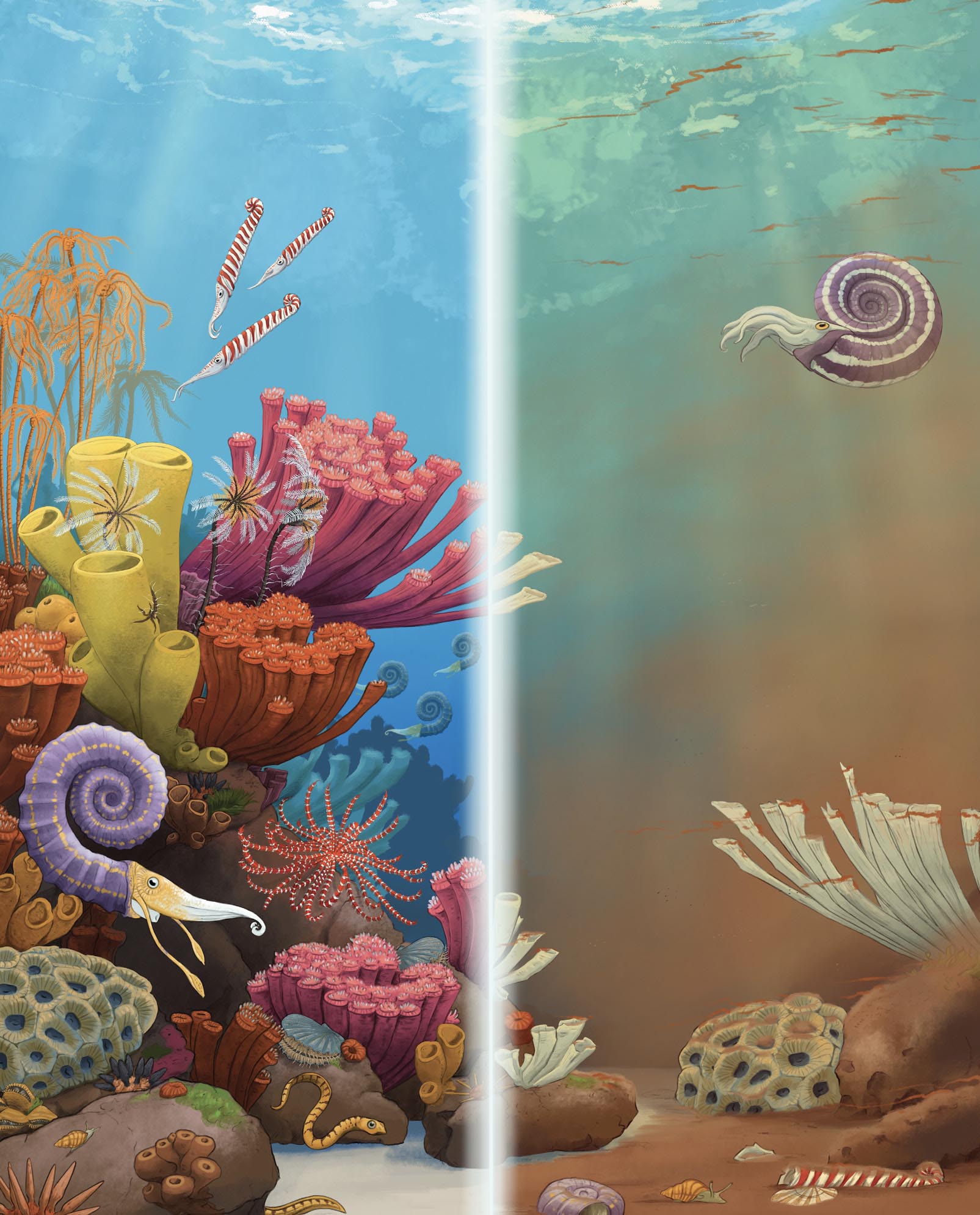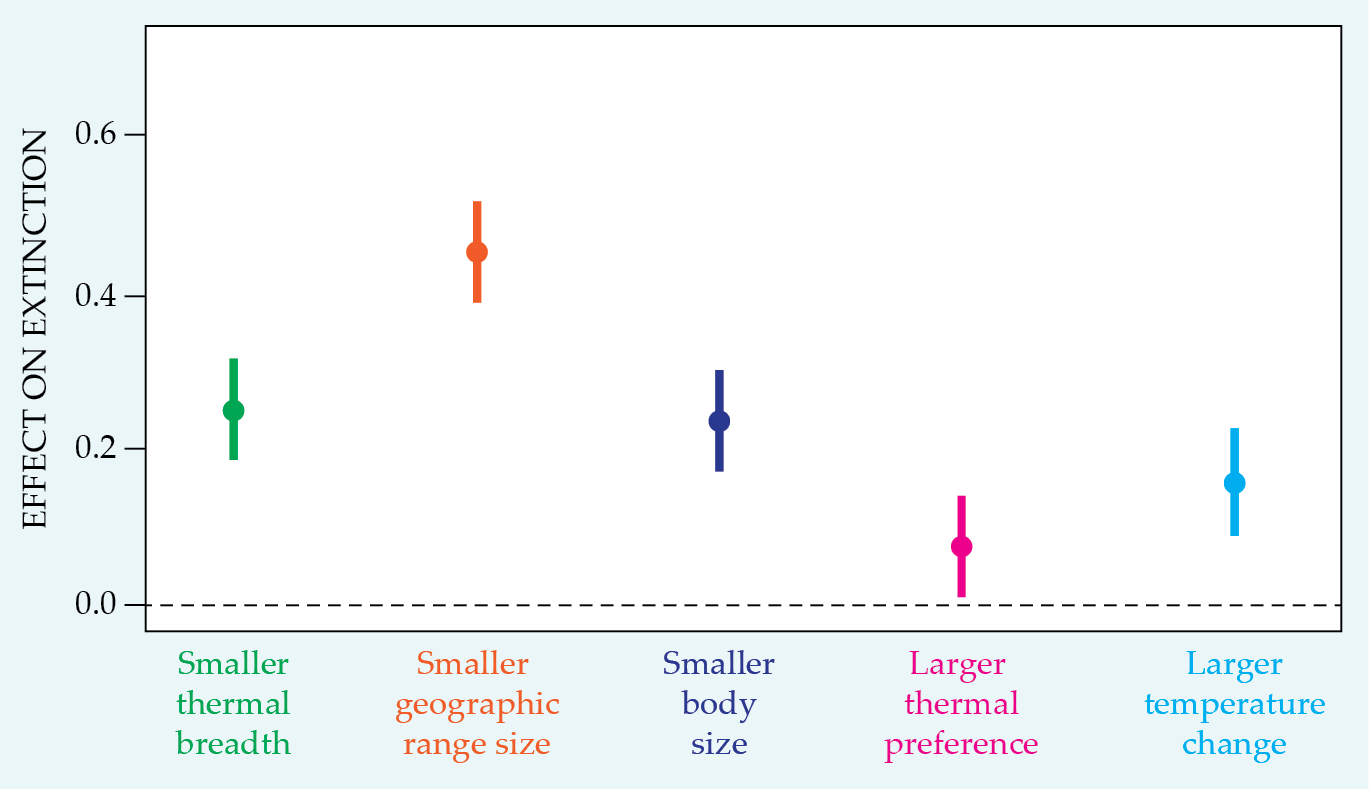Climate change drives extinction—and always has
DOI: 10.1063/pt.ojbx.srdb
To learn how Earth’s species go extinct, scientists have often focused on what’s readily available from the fossil record—organisms’ intrinsic traits, such as their body size or the geographic range they occupy. Yet some of the largest mass extinctions in the geologic past have also been connected to a different factor: extrinsic climate change. The sparse fossil record makes it difficult to estimate the climate contributions to extinction for specific times and places. Most studies, therefore, have treated intrinsic and extrinsic factors separately.
A 2021 climate study, for example, looked only at temperature over the past 450 million years, when animals and plants became abundant on Earth. It found that a historical increase of 5 °C reduced global biodiversity (see figure
Figure 1.

Mass extinction hit Earth’s oceans some 200 million years ago, as illustrated by the difference in the number of organisms before (left) and after (right) ocean temperatures increased. Researchers used fossils of marine invertebrates, such as the nautiluses, snails, and sea lilies shown here, to better understand the causes of extinction over roughly the last half a billion years. (Courtesy of Maija Karala.)

Now Cooper Malanoski and Erin Saupe of the University of Oxford and their colleagues have found a way to look at the combined effects of intrinsic and extrinsic factors on the extinctions of marine invertebrates across geologic time. In their integrated analysis, they found that even organisms with advantageous traits are threatened by climate change. 2
“The field of paleontology is making major advances in recent times at moving from simply recognizing patterns of extinction in the fossil record to testing among potential underlying causes,” says Jonathan Payne of Stanford University. “This study, to me, is among the most complete ever attempted in that direction.”
Mixed model
The history of marine invertebrates is told in their shells. The hard calcified remains are preserved continuously in sedimentary rocks, leaving fossils suitable for analysis. The extinction data—that is, the occurrence of a genus in the fossil record, with the last observation indicating when it went extinct—come from the public Paleobiology Database. The researchers used about 300 000 individual occurrences of various genera.
Why group organisms by genus, rather than by species? The fossil record makes a finer-grained taxonomic analysis difficult. Consider the genus Felis, for example, which includes the domesticated house cat and several wildcats. “It’d be really hard to reconstruct precisely when exactly each species appeared,” says Bruce Lieberman, a paleobiologist from the University of Kansas, “rather than say some type of cat belonging to the genus Felis appeared 5 million years ago.”
In addition to occurrence patterns over time, data from extinct and living genera record two traits that have previously been tied closely to extinction: body size and geographic range. In contrast to what we’re familiar with on land—where larger animals are typically more vulnerable—smaller-bodied marine organisms more frequently go extinct. The counterintuitive finding, says Saupe, “is likely due to body size being correlated with metabolic rates, fecundity, and dispersal ability. However, the exact mechanisms are unknown.”
To study intrinsic and extrinsic factors together, the researchers came up with a way to calculate thermal predictors of extinction using results from the Hadley Centre Coupled Model (HadCM3). Compared with other general circulation models of Earth’s climate, HadCM3 has relatively low resolution, and thus the model runs faster, which is critical when simulating past climates for thousands of years. In 2017 one of Malanoski and Saupe’s coauthors, Paul Valdes of the University of Bristol, made a version of the model with several modifications that further optimized it for paleoclimate simulations. 3
For the new study, Valdes and two coauthors ran a new version of the Bristol HadCM3 model and took sea-surface temperature results from dozens of time slices across the past 485 million years that were matched to the geography of the genera. Then Malanoski and colleagues used the temperature results to calculate two thermal predictors: thermal breadth—defined as the range of temperatures in the area that a genus occupies—and thermal preference, which is the temperature variation that a genus withstands for each time period.
“In the beginning stages of this project, we wanted to compare physiological traits such as thermal breadth and thermal preference to known predictors of extinction risk such as geographic range and body size,” says Saupe. “As the project progressed, we had the thought to compare these traits to the amount of climate change that a species experienced.” To make the comparison of extinction factors, Malanoski and colleagues used a type of linear regression that tests the relative contributions of each of the intrinsic traits and the extrinsic climate factor. Other potential confounding factors, such as greenhouse gas concentrations, Earth’s orbital motion, and the movement of the planet’s tectonic plates, were partially accounted for in the model as additional time-varying effects and were used to quantify uncertainty.
Climate consequences
“Our initial hypothesis was that geographic range size would be the most significant predictor of extinction risk,” says Malanoski. The regression results, plotted in figure
Figure 2.

Extinction risk is affected by multiple factors. Although extrinsic temperature change had a smaller effect on extinction than geographic range, it’s independent of the other analyzed factors and may thus threaten organisms, regardless of their traits. Thermal breadth is defined as temperature range in the area that a genus occupies; thermal preference is the temperature variation that an organism withstands over a time period. The analysis spans the last 485 million years, and the vertical lines represent the 95th percentile estimates. (Adapted from ref.

Some of the intrinsic factors analyzed interacted with each other. An organism with a small body and living in a small geographic range, for example, would be more prone to extinction than an organism with a large body and living in a large geographic range. The interactions highlight the complexity of how organisms may respond to evolutionary pressure or environmental changes.
The absolute temperature change, however, had no statistically significant interactions with the other factors. Climate change, therefore, may have an independent effect on extinction risk—an effect that if large enough may threaten organisms, even if they have large bodies or can live in a vast geographic range. In today’s changing climate, the greatest risk of extinction is for genera living predominantly at the poles or the tropics and that have a thermal breadth of 15 °C or less.
Other factors could also affect extinction. Habitat destruction may block the path that organisms would travel to reach other locations (see Physics Today, September 2019, page 16
References
1. H. Song et al., Nat. Commun. 12, 4694 (2021). https://doi.org/10.1038/s41467-021-25019-2
2. C. M. Malanoski et al., Science 383, 1130 (2024). https://doi.org/10.1126/science.adj5763
3. P. J. Valdes et al., Geosci. Model Dev. 10, 3715 (2017). https://doi.org/10.5194/gmd-10-3715-2017
More about the Authors
Alex Lopatka. alopatka@aip.org

